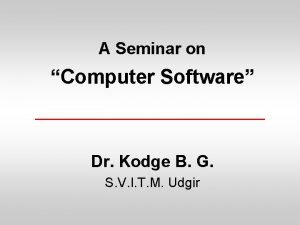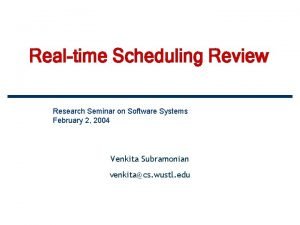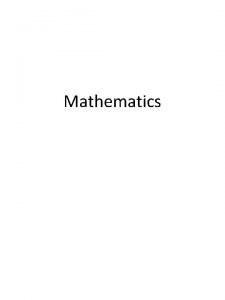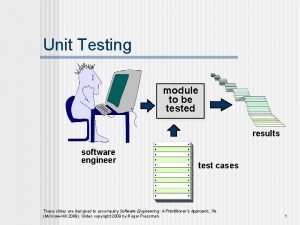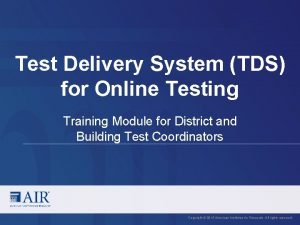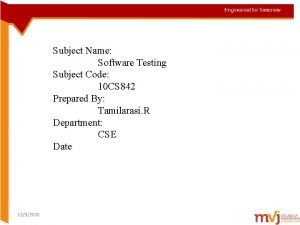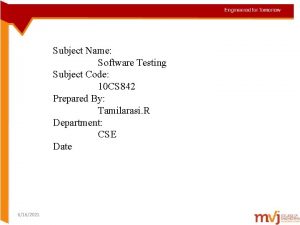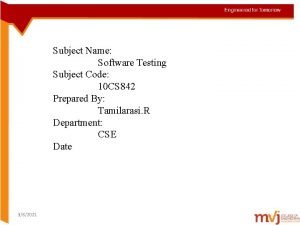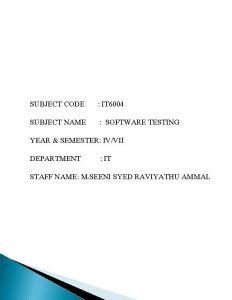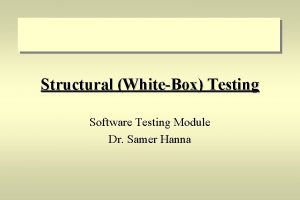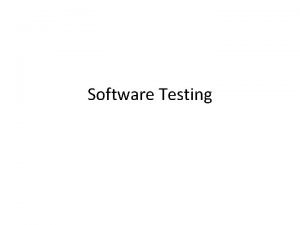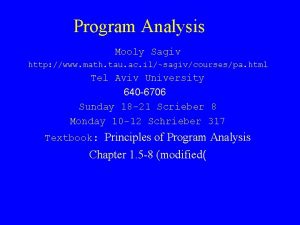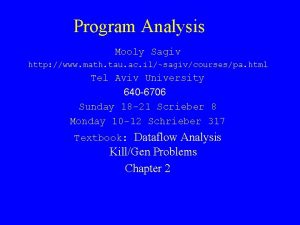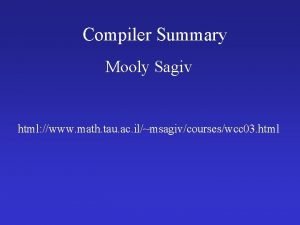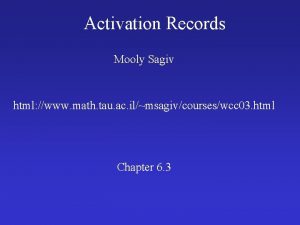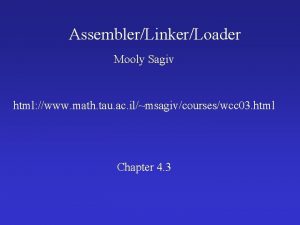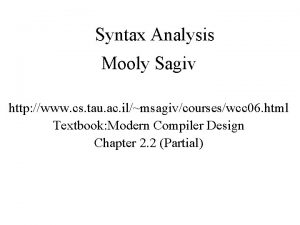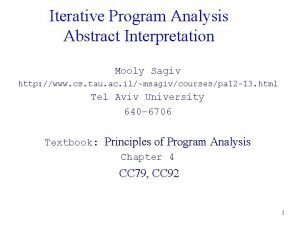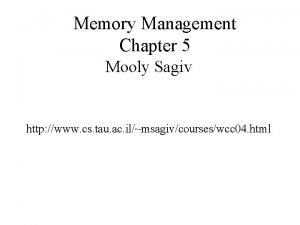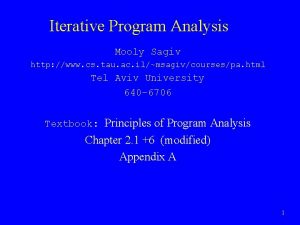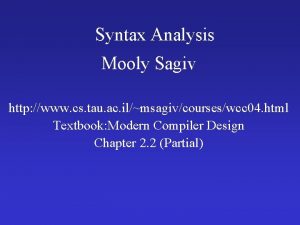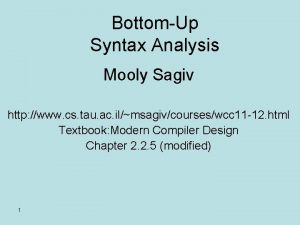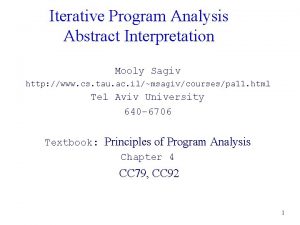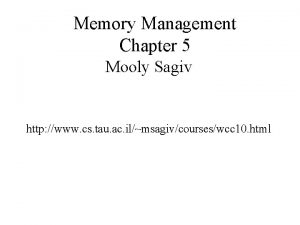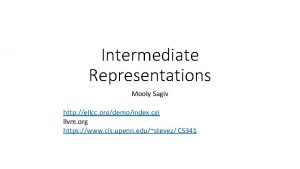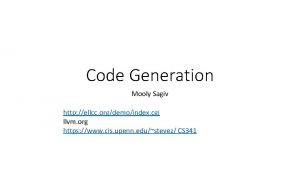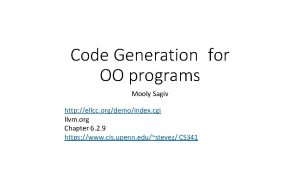Software Testing Seminar Mooly Sagiv http www math






































- Slides: 38

Software Testing Seminar Mooly Sagiv http: //www. math. tau. ac. il/~sagiv/courses/testing. html Tel Aviv University 640 -6706 Sunday 16 -18 Monday 10 -12 Schrieber 317

Bibliography • Michael Young, University of Oregon UW/MSR 1999 • Glenford Myers “The Art of Software Testing” 1978!

Outline • • Testing Questions Goals of Testing The Psychology of Testing Program Inspections and Reviews Test Case Design Achieving Reliability Other Techniques A Success Story

Standard Testing Questions • Did this test execution succeed or fail? – Oracles • How shall we select test cases? – Selection; generation • How do we know when we’ve tested enough? – Adequacy • What do we know when we’re done? – Assessment

Possible Goals of Testing • Find faults – Glenford Myers, The Art of Software Testing • Provide confidence – of reliability – of (probable) correctness – of detection (therefore absence) of particular faults

Testing Theory (such as it is) • Plenty of negative results – Nothing guarantees correctness – Statistical confidence is prohibitively expensive – Being systematic may not improve fault detection • as compared to simple random testing • So what did you expect, decision procedures for undecidable problems?

What Information Can We Exploit? • Specifications (formal or informal) – in Oracles – for Selection, Generation, Adequacy • Designs –… • Code – for Selection, Generation, Adequacy • Usage (historical or models) • Organization experience

The Psychology of Testing • “Testing is the process of demonstrating that an errors are not present” • “Testing is the process of establishing confidence that the program does what it intends to do” • “Testing is the process of executing programs with the intent of finding errors” – Successful (positive) test: exposes an error

Black Box Testing • View the program as a black box • Exhaustive testing is infeasible even for tiny programs – – Can never guarantee correctness Fundamental question is economics “Maximize investment” Example: “Partition test”

White Box Testing • Investigate the internal structure of the program • Exhaustive paths testing is infeasible • Does not even guarantee correctness – Specification is needed – Missing paths – Data dependent paths if (a-b < epsilon) • Becomes an economical question

Testing Principles • Test case must include the definition of expected results • A program should not test her/his own code • A programming organization should not test its own programs • Thoroughly inspect the results of each test • Test cases must be also written for invalid inputs • Check that programs do not do unexpected things • Test cases should not be thrown a way • Do not plan testing assuming that there are no errors • The probably of error in a piece of code is proportional to the errors found so far in this part of the code

Program Inspections and Reviews • Conducted in groups/sessions • A well established process • Modern programming languages eliminate many programming errors: – Type errors – Memory violations – Uninitialized variables • But many errors are not currently found – Division by zero – Overflow – Wrong precedence of logical operators

Test Case Design • What subset of inputs has the highest probability of detecting the most errors? • Combine black and white box testing

Higher Order Testing • Show that the program does not so what the end-user expects… • Different testing levels – – Unit test (procedure boundaries) Module test Function test (discrepancies external spec. ) System test (discrepancies with original objectives) • • • Facility test Volume test Usability test Security test Performance test. . .

Black box White box • Equivalence partitioning • Coverage/Adequacy • Boundary-value analysis • Data flow analysis • Cause-effect graphing • Cleanness • Error guessing • Correctness • State space exploration • Mutation • Slicing

Partition Testing (Equivalence Partitioning) • Basic idea: Divide program input space into (quasi-) equivalence classes – Underlying idea of specification-based, structural, and fault-based testing

Specification-Based Partition Testing • Divide the program input space according to identifiable cases in the specification – May emphasize boundary cases – May include combinations of features or values • If all combinations are considered, the space is usually too large • Systematically “cover” the categories – May be driven by scripting tools or input generators – Example: Category-Partition testing [Ostrand]

“Adequate” testing • Ideally: adequate testing ensures some property (proof by cases) – Origins in [Goodenough & Gerhart], [Weyuker and Ostrand] – In reality: as impractical as other program proofs • Practical “adequacy” criteria are really “inadequacy” criteria – If no case from class XX has been chosen, surely more testing is needed. . .

Structural Coverage Testing • )In)adequacy criteria – If significant parts of program structure are not tested, testing is surely inadequate • Control flow coverage criteria – – Statement (node, basic block) coverage Branch (edge) and condition coverage Data flow (syntactic dependency) coverage Various control-flow criteria • Attempted compromise between the impossible and the inadequate

Basic structural criteria (ex. ) a Edge ac is required by all-edges but not by all-nodes coverage b Typical loop coverage criterion would require zero iterations (cdf), one iteration (cdedf), and multiple iterations (cdededed. . . df) c d e f

Data flow coverage criteria (ex. ) x : = 7 Rationale: An untested defuse association could hide an erroneous computation y : = x y : = y+1 z : = x+y 2 reaching definitions )one is from self( 2 reaching definitions for x , and 2 reaching definitions for y

The Infeasibility Problem • Syntactically indicated behaviors (paths, data flows, etc. ) are often impossible – Infeasible control flow, data flow, and data states • Adequacy criteria are typically impossible to satisfy • Unsatisfactory approaches: – Manual justification for omitting each impossible test case (esp. for more demanding criteria) – Adequacy “scores” based on coverage • example: 95% statement coverage, 80% def-use coverage

Challenges in Structural Coverage • Interprocedural and gross-level coverage – e. g. , interprocedural data flow, call-graph coverage • Regression testing • Late binding (OO programming languages) – coverage of actual and apparent polymorphism • Fundamental challenge: Infeasible behaviors – underlies problems in inter-procedural and polymorphic coverage, as well as obstacles to adoption of more sophisticated coverage criteria and dependence analysis

Structural Coverage in Practice • Statement and sometimes edge or condition coverage is used in practice – Simple lower bounds on adequate testing; may even be harmful if inappropriately used for test selection • Additional control flow heuristics sometimes used – Loops (never, once, many), combinations of conditions

Testing for Reliability • Reliability is statistical, and requires a statistically valid sampling scheme • Programs are complex human artifacts with few useful statistical properties • In some cases the environment (usage) of the program has useful statistical properties – Usage profiles can be obtained for relatively stable, pre-existing systems (telephones), or systems with thoroughly modeled environments (avionics)

Certifying Ultra-High reliability • Problem: How can I show that system X has an expected failure rate of 10 -9/hour? – example: probability that software will ever bring down an Airbus A 320 • Butler & Finelli estimate – for 10 -9 per 10 hour mission – requires: 1010 hours testing with 1 computer – or: 106 hours (114 years) testing with 10, 000 computers [ACM Sigsoft 91, Conf. on SW for Critical Systems]

Glimmers of Hope for Measuring High Reliability • Random distribution of faults or failures would enable statistical reasoning and classic redundancy techniques – A whole more reliable than its parts • Randomization approaches – Blum: Self-checking programs – Lipton: Redundant computations – Podgurski: Kolmogorov complexity • Grail or illusion? – Difficult to generalize beyond simple functions

Process-Based Reliability Testing • Rather than relying only on properties of the program, we may use historical characteristics of the development process • Reliability growth models (Musa, Littlewood, et al) project reliability based on experience with the current system and previous similar systems

Fault-based testing • Given a fault model – hypothesized set of deviations from correct program – typically, simple syntactic mutations; relies on coupling of simple faults with complex faults • Coverage criterion: Test set should be adequate to reveal (all, or x%) faults generated by the model – similar to hardware test coverage

Fault Models • Fault models are key to semiconductor testing – Test vectors graded by coverage of accepted model of faults (e. g. , “stuck-at” faults) • What are fault models for software? – What would a fault model look like? – How general would it be? • Across application domains? • Across organizations? • Across time? • Defect tracking is a start

The Budget Coverage Criterion • A common answer to “when is testing done” – When the money is used up – When the deadline is reached • This is sometimes a rational approach! – Implication 1: Test selection is more important than stopping criteria per se. – Implication 2: Practical comparison of approaches must consider the cost of test case selection

Test Selection: Standard Advice • Specification coverage is good for selection as well as adequacy – applicable to informal as well as formal specs • + Fault-based tests – usually ad hoc, sometimes from check-lists • Program coverage last – to suggest uncovered cases, not just to achieve a coverage criterion

The Importance of Oracles • Much testing research has concentrated on adequacy, and ignored oracles • Much testing practice has relied on the “eyeball oracle” – Expensive, especially for regression testing • makes large numbers of tests infeasible – Not dependable • Automated oracles are essential to costeffective testing

Sources of Oracles • Specifications – sufficiently formal (e. g. , Z spec) – but possibly incomplete (e. g. , assertions in Anna, ADL, APP, Nana) • Design models – treated as specifications, as in protocol conformance testing • Prior runs (capture/replay) – especially important for regression testing and GUIs; hard problem is parameterization

What can be automated? • Oracles – assertions; replay; from some specifications • Selection (Generation) – scripting; specification-driven; replay variations – selective regression test • Coverage – statement, branch, dependence • Management

Design for Test: 3 Principles Adapted from circuit and chip design • Observability – Providing the right interfaces to observe the behavior of an individual unit or subsystem • Controllability – Providing interfaces to force behaviors of interest • Partitioning – Separating control and observation of one component from details of others

Problems & Opportunities • Compositionality – for components; for regression • Specifications – low entry barrier, incremental payoff • Synergy with Analysis – conformance test w/ verified models – “backstop” for unsafe assumptions • … (your idea here)

A recent success story • The Prefix program analysis tool • Analyzes C/C++ sources • Scans for cleanness bugs, e. g. , dereferences to NULL pointers • Symbolically executes the program on some paths • May miss some errors and generate false alarms • Tried on Windows 2000 • Located 65, 000 potential bugs 28, 000 out of which are real bugs
 Mooly sagiv
Mooly sagiv Domain testing
Domain testing Logic based testing
Logic based testing Du path testing
Du path testing What is globalization testing
What is globalization testing What is testing
What is testing Control structure testing in software testing
Control structure testing in software testing Decision table testing in software testing
Decision table testing in software testing Decision table based testing
Decision table based testing Table based testing
Table based testing Rigorous testing in software testing
Rigorous testing in software testing Testing blindness in software testing
Testing blindness in software testing Domain testing example
Domain testing example Seminar about computer software
Seminar about computer software Seminar scheduling software
Seminar scheduling software Positive vs negative testing
Positive vs negative testing Static testing and dynamic testing
Static testing and dynamic testing Neighborhood integration testing
Neighborhood integration testing Definisi black box testing
Definisi black box testing Behavior testing adalah
Behavior testing adalah Component testing is a black box testing
Component testing is a black box testing Http //mbs.meb.gov.tr/ http //www.alantercihleri.com
Http //mbs.meb.gov.tr/ http //www.alantercihleri.com Siat.ung.ac.id
Siat.ung.ac.id · meaning in math
· meaning in math Hit the button
Hit the button State graphs in software testing
State graphs in software testing What is unit testing in software
What is unit testing in software Path sensitizing in software testing
Path sensitizing in software testing Dichotomies in stm
Dichotomies in stm Linda
Linda Tds in software testing
Tds in software testing Software testing subject code
Software testing subject code Software testing subject code
Software testing subject code Insights from a venn diagram in software testing
Insights from a venn diagram in software testing It6004
It6004 Dr samer hanna
Dr samer hanna Software testing definition
Software testing definition State graphs in software testing
State graphs in software testing Software testing process
Software testing process













